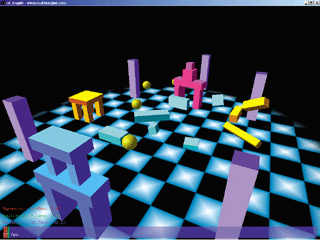This page is to talk about the physics engines used. A physics engine is code that its main goal is calculate all the equations that would go in the certain problem and then produce the working image. Alex Rivers says: a physics engine that can simulate just about anything you can throw at it. It can handle objects that bounce, roll, stretch, break, get sliced, get crushed, and everything in between, even simulating fluids with ease. It does have weaknesses - ironically, it is not very good at large, rigid objects, which were the easiest thing to simulate with rigid body physics - but its capability for destruction offers a wealth of new possibilities in terms of game play. (http://www.aidspan.org/alec/physical/overview_physics.htm)
There are 2 main physics engines used in video games today. MathEngine's Dynamics Toolkit 2.0, and the Havok GDK from Havok.
These engines have become the standard now to try to make video games a lot more realistic when they use physics. Games are becoming a lot more fun once things around the character now can more in a realistic manner.
When the Video Game Max Payne 2 that came out last year, it was the first game to use the new Havok engine. Now boxes will move when you hit them..wood would break when it was shot at. This was all brand new to the world to happen. Having this happen made the game a lot more fun and seem more realistic.

above image courtesy of http://www.rockstargames.com/maxpayne2/ss/screen27.jpg
There were also things that made the game not at all realistic. This game also had the "Bullet Time", which was made famous from the movie The Matrix

above image courtesy of http://www.rockstargames.com/maxpayne2/ss/screen01.jpg
Other games currently used with the havok physics engine are Half-life 2, Medal of Honor Pacific Assault, Full Spectrum Warrior, and Pain Killer.
Mathengine is currently used in games such as Unreal Tournament.

This is a dynamically controlled object in a scene with MathEngine used as the code.
Above image courtesy of http://www.gamasutra.com/features/20000920/lander_03.htm
Current Physics engines used for video games do not come cheap. MathEngine costs either a single fee of $50,000 per project, or $5,000 plus royalty of 50 cents per unit. The Havok GDK is available for $65,000 to $75,000 per title without royalties. Royalty pricing and other pricing options are available on an individual basis.
Most game companies don't make their own physic engines. They buy the engine and it cuts the time of making the game in half.